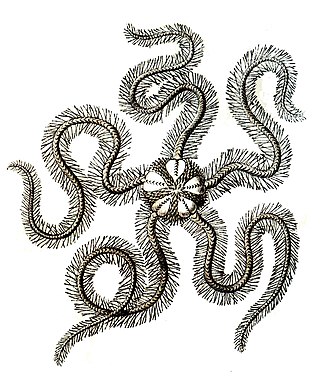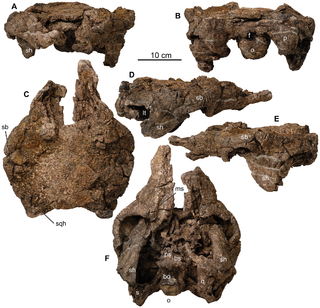
An echinoderm is any deuterostomal animal of the phylum Echinodermata, which includes starfish, brittle stars, sea urchins, sand dollars and sea cucumbers, as well as the sessile sea lilies or "stone lilies". While bilaterally symmetrical as larvae, as adults echinoderms are recognisable by their usually five-pointed radial symmetry, and are found on the sea bed at every ocean depth from the intertidal zone to the abyssal zone. The phylum contains about 7,600 living species, making it the second-largest group of deuterostomes after the chordates, as well as the largest marine-only phylum. The first definitive echinoderms appeared near the start of the Cambrian.

Sea urchins or urchins are typically spiny, globular animals, echinoderms in the class Echinoidea. About 950 species live on the seabed, inhabiting all oceans and depth zones from the intertidal to 5,000 metres. Their tests are round and spiny, typically from 3 to 10 cm across. Sea urchins move slowly, crawling with their tube feet, and sometimes pushing themselves with their spines. They feed primarily on algae but also eat slow-moving or sessile animals. Their predators include sea otters, starfish, wolf eels, and triggerfish.

Starfish or sea stars are star-shaped echinoderms belonging to the class Asteroidea. Common usage frequently finds these names being also applied to ophiuroids, which are correctly referred to as brittle stars or basket stars. Starfish are also known as asteroids due to being in the class Asteroidea. About 1,900 species of starfish live on the seabed in all the world's oceans, from warm, tropical zones to frigid, polar regions. They are found from the intertidal zone down to abyssal depths, at 6,000 m (20,000 ft) below the surface.

Fish anatomy is the study of the form or morphology of fish. It can be contrasted with fish physiology, which is the study of how the component parts of fish function together in the living fish. In practice, fish anatomy and fish physiology complement each other, the former dealing with the structure of a fish, its organs or component parts and how they are put together, such as might be observed on the dissecting table or under the microscope, and the latter dealing with how those components function together in living fish.
The water vascular system is a hydraulic system used by echinoderms, such as sea stars and sea urchins, for locomotion, food and waste transportation, and respiration. The system is composed of canals connecting numerous tube feet. Echinoderms move by alternately contracting muscles that force water into the tube feet, causing them to extend and push against the ground, then relaxing to allow the feet to retract.

Brittle stars, serpent stars, or ophiuroids are echinoderms in the class Ophiuroidea, closely related to starfish. They crawl across the sea floor using their flexible arms for locomotion. The ophiuroids generally have five long, slender, whip-like arms which may reach up to 60 cm (24 in) in length on the largest specimens.

The Phrynophiurida are an order of brittle stars containing the basket stars.

Drepanaspis is an extinct genus of heterostracan armoured jawless fish from the Early Devonian. Drepanaspis are assumed to have lived primarily in marine environments and is most commonly characterized by their ray-like, heavily armoured bodies, along with their lack of paired fins and jaws.
Breitensteinia is a genus of catfishes of the family Akysidae. It includes three species.
The development of the reproductive system is the part of embryonic growth that results in the sex organs and contributes to sexual differentiation. Due to its large overlap with development of the urinary system, the two systems are typically described together as the genitourinary system.
Ophiocanops fugiens is a living species in the brittle star family Ophiocanopidae. Though once considered to be the only one living species in this brittle star family, recent research has brought to light three specimens of Ophiocanops that differ substantially from O. fugiens. It has been regarded as the most primitive brittle star, close to Paleozoic forms, though other authors have disagreed with the view. Classification of O. fugiens is highly argued. Ophiocanops is usually placed in the order Oegophiurida or regarded as a genus incertae sedis or even given its own subclass Oegophiuridea. Some recent data suggest its relationship to the extant family Ophiomyxidae.

The reproductive system of gastropods varies greatly from one group to another within this very large and diverse taxonomic class of animals. Their reproductive strategies also vary greatly.

Insect morphology is the study and description of the physical form of insects. The terminology used to describe insects is similar to that used for other arthropods due to their shared evolutionary history. Three physical features separate insects from other arthropods: they have a body divided into three regions, three pairs of legs, and mouthparts located outside of the head capsule. This position of the mouthparts divides them from their closest relatives, the non-insect hexapods, which include Protura, Diplura, and Collembola.

The Asterozoa are a subphylum in the phylum Echinodermata. Characteristics include a star-shaped body and radially divergent axes of symmetry. The subphylum includes the class Asteroidea, the class Ophiuroidea, and the extinct order Somasteroidea.
Xyloplax medusiformis is a sea daisy, a member of an unusual group of marine taxa belonging to the phylum Echinodermata. It is found at bathyal depths in waters around New Zealand. It was first described in 1986 by Baker, Rowe and Clark and is the type taxon of the genus Xyloplax. Its generic name derives from the Greek "xylo" meaning wood and its specific name was chosen because its morphology superficially resembles that of a cnidarian medusa.

Gastrodiscoides is genus of zoonotic trematode under the class Trematoda. It has only one species, Gastrodiscoides hominis. It is a parasite of a variety of vertebrates, including humans. The first definitive specimen was described from a human subject in 1876. It is prevalent in Bangladesh, India, Burma, China, Kazakhstan, Philippines, Thailand, Vietnam, and the Volga Delta of Russia, with isolated cases from Africa, such as Nigeria. It is especially notable in the Assam, Bengal, Bihar, Madhya Pradesh, Orissa and Uttar Pradesh regions of India.

Ossicles are small calcareous elements embedded in the dermis of the body wall of echinoderms. They form part of the endoskeleton and provide rigidity and protection. They are found in different forms and arrangements in sea urchins, starfish, brittle stars, sea cucumbers, and crinoids. The ossicles and spines are the only parts of the animal likely to be fossilized after an echinoderm dies.

Europelta is a monospecific genus of nodosaurid dinosaur from Spain that lived during the Early Cretaceous in what is now the lower Escucha Formation of the Teruel Province. The type and only species, Europelta carbonensis, is known from two associated partial skeletons, and represents the most complete ankylosaur known from Europe. Europelta was named in 2013 by James I. Kirkland and colleagues. Europelta has an estimated length of 5 metres and weight of 1.3 tonnes, making it the largest member of the clade Struthiosaurini.
Ophiozonella depressa is a species of brittle stars from the family Hemieuryalidae. This species is a type of echinoderm which lives in deep-sea benthic environments. First described by Theodore Lyman in 1878, and then later confirmed by H. Matsumoto in 1915.

Asterolepis is an extinct genus of antiarch placoderms from the Devonian of North and South America and Europe. They were heavily armored flat-headed benthic detritivores with distinctive jointed limb-like pectoral fins and hollow spine. The armor plate gives the Asterolepis a box-like shape. Its pectoral fins are also armored but the caudal and dorsal fin are not. The first fossils were named by M. Eichwald in 1840 after noticing star-like markings on the fossils.













